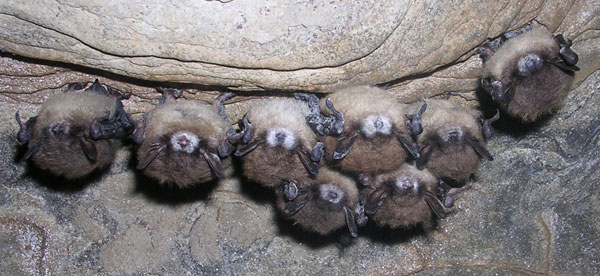Bats continue to be devastated by white-nose syndrome

Bats infected with White-nose Syndrome in Hailes Cave near Albany, NY. Photo: Nancy Heaslip, DEC
Here’s a Canadian update on the plight of bats affected by white-nose syndrome, a topic followed in detail by Brian Mann as that outbreak came to light.
Earlier this year, CBC news reported the impact of white-nose in Canada’s Atlantic provinces has been quite severe – perhaps up to 99% of New Brunswick’s overwintering bat population has been killed. For those who may shrug and say “so what”, the CBC article offered more to consider:
Bats can live between 30 and 35 years and have a relatively low birth rate, with only one offspring born every year, so it could take many years for the population to recover, scientists have said.
The declining bat population is a serious problem because bats are a natural form of pest control, officials have said.
If there aren’t enough bats to eat insects and help control insect populations, that could have a serious impact on farming, pesticide use, and the price of food.
This past week something called the Committee on the Status of Endangered Wildlife in Canada (COSEWIC) recommended Federal Environment Minister Leona Aglukkaq grant endangered status to three bat species: the little brown, the northern and the tri-coloured bats.
In case you’re wondering, here’s an explanation of that committee from their website: COSEWIC “… is a committee of experts that assesses and designates which wildlife species are in some danger of disappearing from Canada.”
According to CBC Aglukkaq is required to respond to that request within 90 days. Options include accepting or rejecting the recommendation – or requesting additional information.
Here’s the view on the bats in question, from a larger COSEWIC December press release discussing 28 Canadian wildlife species assessed as “at risk” during recent COSEWIC meetings held in Ottawa this past November:
Three bat species assessed at this meeting remind us again that even the most abundant wildlife populations can plummet rapidly. In late 2011, wildlife officials in Nova Scotia asked COSEWIC to assess the Little Brown Myotis, Northern Myotis, and Tri-colored Bat. Alarming numbers of hibernating bats were dying from an introduced fungal disease known as White-nose Syndrome. This fungus flourishes in the caves and mines where these bats overwinter. Each of these three bats has experienced steep declines of up to 94% since the disease arrived in Canada in 2010, and millions of bats have died in northeastern North America. White-nose Syndrome first appeared in a cave in central New York in 2006, and has spread 200-250 km per year into 22 U.S. states, as well as Ontario, Quebec, Nova Scotia, New Brunswick, and Prince Edward Island. The disease is expected to spread across North America within two decades, and is likely to affect other species of hibernating bats. COSEWIC confirmed its emergency assessment of 2012, assessing all three bats as Endangered.
For these three bat species, the road to recovery will be long. The disease is still spreading, bat populations will continue to decline, and successful recovery is not guaranteed. We have learned from limited successes with other species that a coordinated approach that includes scientific research, effective conservation management, public awareness and private and public stewardship provides the best chance that these bats will once again fill our night skies.
The group White-nose syndrome.org has more information on this subject, including a map of the spread of white-nose syndrome to date and a section on what you can do to help.
Tags: bats, canada, envieonment, science, white nose syndrome







